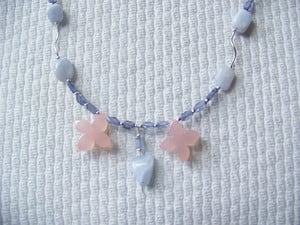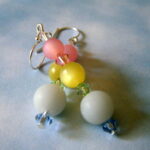So you’ve mastered the basic techniques of beading, and you’ve purchased some beads and findings that you like, now what? This is where many people are stumped. In fact, it seems that in crafts there are often two kinds of people: those who are really the creative or visionary type but who aren’t that good with the technical aspects of their art, and those who are a whiz at actually doing their craft but who just don’t know where to begin.
In the next few paragraphs I’m going to explain something that I hope you will not only apply to beading, but will, I hope, also apply to other creative aspects of your life.
Generally speaking, you don’t often use even numbers when doing creative work. That doesn’t mean that it’s forbidden, but that odd numbers are usually considered more visually pleasing. This is not merely true for beading; it is true for virtually all types of crafts, etc. My experience first came from gardening (if you are a gardener, please read my other posts on gardening) and it was there that I learned about the power of three. Unless you are flanking a walkway or something like that, how often do you see two shrubs together? Not very. But put three shrubs together, and voila! You have the beginning of a garden.
The same is true for beading. If your patterns are always based on two and four beads of the same kind together, the eye can too quickly discern those beads, and it becomes boring. But put three beads together and it becomes more exciting, more vibrant, and something that the eye can not rapidly grasp.
There are numerous ways that the power of three can be accomplished. I am attaching some pictures of a few simple beaded pieces. Think about how the pieces would be different if there had been two or four beads in place of three in these pieces.
However, these pieces are just a sliver of what you can do with the power of three. I can’t begin to give you enough examples, especially considering the multitude of methods of beading out there. Just know it would be a mistake to think that the power of three always meant you had to go something like AAA BBB AAA BBB. No, you could, perhaps, try AB AB AB C AB AB AB C AB AB AB CCC. As you can see, the power of three is used three times in this example, once with the AB’s a second time with the C’s after the AB’s, and then with the CCC’s.
I am not suggesting that you never should use an even number or that everything you do should be done in threes. But I am suggesting you look to the power of three should you be at a loss for inspiration. So, the next time you are stumped for a beading idea, lay those bead in front of you and put them in threes. I bet you’ll come up with something pleasing in no time.




